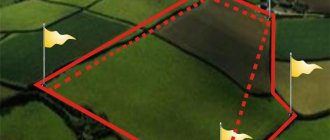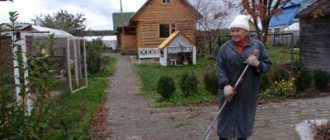You went on vacation, and when you returned, you discovered that during your absence, your neighbor in the countryside had completed a garage. And everything would be fine if this building did not invade your territory. You are not ready to put up with the fact that the spreading branches of the cherry tree now rest against a brick wall, and you are starting to fight for hundreds of acres. Many land owners have to deal with situations like this.
We will respond within 60 seconds
Free consultation+7
How to resolve a dispute with neighbors about the boundaries of a land plot
To prove that you are right in a land conflict, you need to arm yourself with documents, the main one of which is a cadastral passport. It not only confirms the owner’s rights to the land - it also records the boundaries of ownership determined during land surveying.
If boundaries are not set
If land surveying has not been carried out, neighbors may argue until they are hoarse and not come to a consensus. This is because their ideas about the location of the demarcation strip are radically different. It is impossible to judge the disputants in this case: land plots are registered formally in the cadastral register, therefore, the boundaries between them are defined conditionally. There is only one way out of the situation - to carry out land surveying.
What does land surveying give?
This is a legal way to make a division, establish the area of each plot and fix the boundaries. The process is carried out with the involvement of specialists from the field of topographic and geodetic work. Owners of adjacent plots must be notified of the upcoming procedure. Without agreement with them, the issued act on establishing boundaries may be declared invalid. After completing the work and receiving the approval of neighbors, the land owner receives a cadastral passport. From this moment on, any encroachments by “adjacent partners” on the owner’s hundred square meters can be easily prevented.
If the area is demarcated
Borders have been established, but one of the owners believes that part of his legal territory has been captured by his neighbor. He assures that the strip separating the plots on the paper plan should in reality run a meter to the left or to the right. In this case, placing the points on the ground will help resolve the conflict.
Drive in the pegs
The removal of points is carried out by specialists from a licensed land management company. They conduct a geodetic survey, make the necessary calculations and transfer the boundaries from the paper diagram to the terrain. For clarity, boundary markers are installed at the dividing points. By driving in a peg, it is easy to determine where the border lies and determine which neighbor is right.
Reasons for disagreement
Neighboring land users refuse to sign the boundary approval act when they do not agree with the location of the boundaries determined by the cadastral engineer.
This may happen for the following reasons:
- Changing the current boundaries after the measurements taken;
- The presence of the fact of imposing boundaries;
- Contradictions in the work of cadastral engineers hired by neighbors;
- The desire of the parties to increase the area of their plots;
- The presence of a dispute between heirs when dividing the land plot into shares;
- Errors in the work of the geodetic service.
Between neighboring plots that are not separated by a passage or driveway (especially in gardening communities), the border usually exists in the form of a symbolic fence or a stretched mesh, on both sides of which plants are planted.
Even a slight shift of such a boundary can lead to the need to carry out work to dismantle the installed mesh and other inconveniences.
This can be avoided by mutual agreement of the parties, but if the customer of the work or the interested party decided in principle to establish boundaries accurate to the centimeter, disagreements cannot be avoided.
When inheriting one piece of land by several heirs,
boundary work to divide the plot into separate plots, the areas of which are proportional to the shares of the heirs, and disputes arise when determining the location of new boundaries between the newly formed plots, especially when there is an uneven distribution of buildings and plant crops on the inherited plot.
If the newly measured boundaries turn out to be superimposed on the boundaries of a neighboring area as a result of various reasons, for example, errors in calculations, then this also leads to disagreements.
When land disputes between neighbors are decided by the court
It happens that even the removal of points does not convince the landowner, and he refuses to demolish part of the extension from the neighbor’s legal territory. If peace negotiations reach a dead end, there is nothing left to do but resolve the dispute in court. Such claims are considered by district courts; a cadastral passport and a boundary plan should be attached to the application. If possible, you should support your position with testimony from witnesses. During the consideration of the case, it may be necessary to conduct a land management examination. Sometimes it is appointed by the court, but more often one of the parties to the conflict requests it.
Features and nuances
When preparing for trial, you need to pay special attention to the type of controversy that has arisen. Disputes about squatting or imposing boundaries are possible - in these cases the neighbor is the defendant. If we are talking, for example, about a refusal to register a plot of land, then the cadastral chamber is the defendant, and in this case the judicial process takes on its own characteristics.
Each specific case is unique and requires detailed consideration. There is practically no identical judicial practice. If possible, it is recommended to consult not only with a cadastral specialist, but also with a lawyer who will help determine the prospects of the case and potential costs.
Once a decision has been made, it must be enforced. This is where the main difficulty begins. For example, if the dispute concerned squatting, then it is necessary to ensure that the situation is returned to its original state, in accordance with the decision. A neighbor does not always voluntarily vacate the territory, even if this is indicated in the decision (for example, to move a fence at his own expense).
In this case, you must contact the bailiff service. Failure to comply with the instructions of the court and bailiffs may result in additional liability. Also, SSP employees can involve third-party organizations to dismantle an incorrectly constructed fence or other landmarks.
Controversies regarding the boundaries of land plots arise quite often. We can talk about squatting, contradictions in documents, misunderstanding of the real state of affairs. First of all, you need to try to sort out the conflict peacefully, if possible - order an independent examination, measure areas and landmarks. If it is not possible to reach an agreement, then the only option left is to go to court.
Read: How to remove obstacles to the use of land
How to win a land dispute
It is very problematic to recapture acres seized by a neighbor without being an expert in land law. Even experienced lawyers note the complexity and intricacy of this area of legislation. An ignorant person will find it difficult to draw up procedural documents, prepare questions for experts, develop a strategy to protect his interests and follow it during court hearings. All these tasks can be accomplished by experienced lawyers. These people work in our company and will be happy to provide professional support. On their side are specialized education, excellent knowledge of the laws, rich practice, and effective schemes for protecting clients in land disputes in court.
15 years of experience in the legal services market
Legal Agency of St. Petersburg was founded in 2004 and has been successfully operating for 15 years
30 experienced specialists
Our team consists of competent lawyers and attorneys with narrow specialization in certain areas of law
10 years minimum legal experience
All consultations are conducted by lawyers with experience in successfully resolving similar situations, which ensures maximum assistance to the client.
91% of cases won
The results speak for themselves - since 2004, 3,756 cases have been won, 5,073 clients have been satisfied, and 874,474,045 have been paid to them
72% of appealed court decisions
We take on cases of any complexity and at any stage of the process, but the sooner you contact a specialist, the more likely a positive outcome of the case is
24 hours on call
We are ready to handle your case from start to finish, accompanying and supporting you throughout the entire process.
Liability and fines
The listed cases are defined as squatting , violation of the boundaries of a land plot (Article 7.1 of the Code of Administrative Offenses of the Russian Federation) and are subject to sanctions and a fine, the amount of which determines the status of the violator:
- for individuals – from 5 to 10 thousand rubles;
- for legal entities – from 100 to 200 thousand.
The court has the right to impose a penalty based on the cadastral value of the illegally used plot or part thereof. In this case the penalty is:
- for individuals : 1-1.5% of the cadastral value of the occupied land plot;
- for legal entities : 2-3% of the same amount.
A fixed fine is imposed if the cadastral value of the land plot is not established.
After payment of the fine, the responsibility for conscientious observance of boundaries remains in force. Land surveying will help resolve such controversial issues (you can find out what it is here).
Court decisions
What are the consequences of paying a small fine for an administrative offense?
Lost certificate of ownership
Land marking without the consent of neighbors
How to properly register land
In order to know exactly the boundaries of his land plot, the land user - owner or tenant - must have on hand:
- a document confirming the right to be on this site and use it. This may be an extract from the Unified State Register of Property Rights or lease relations;
- the basis for the emergence of this right: certificate of inheritance, lease agreement, deed of gift, purchase and sale or exchange agreement;
- certificate or extract from the Cadastral Chamber. It contains all the technical information about the land plot: address, area, size, number and nature of buildings, purpose of the land, owner, etc. This document contains a graphic part: a site plan with a site;
- boundary plan with clarification of boundaries.
The last document is decisive in disputes about borders.
Customer Reviews
Gratitude from gr. Voronova T.A. I express my gratitude to Yuri Vladimirovich for competent, highly professional advice on the issue of “Protection of Consumer Rights”, a clear explanation of my further actions in my situation, as well as gratitude to Olga Anatolyevna for her attentive and sensitive attitude towards visitors. I was glad to meet your agency!
Voronova Tatyana Anatolyevna
tel.
Customer Feedback We thank the employees of Legal Agency of St. Petersburg LLC and, first of all, Yana Maksimovna Matveeva and Andrey Valerievich Ermakov for their highly qualified and thorough consideration of our issue and the prompt solution to our housing problem.
Also to Daria Valentivna Kutuzov for her attentive and friendly attitude towards visitors.
Gratitude from Truk N.N. I would like to express my gratitude to Vasily Anatolyevich Kavalyauskus, Alexander Viktorovich Pavlyuchenko and Maxim Andreevich Lobur for providing qualified legal assistance, with the help of which my problem was resolved quickly and clearly. When contacted, I always found understanding and attention. It’s good that the “Society for the Protection of Consumer Rights” employs such lawyers and advocates. I wish you success in your future work and defending the interests of consumers.
Sincerely, Truk N.N.
07.05.2018
Gratitude from N.S. Khokhlov I am Khokhlov N.S. I express special gratitude to lawyer A.V. Pavlyuchenko who defended my consumer protection rights. I was pleasantly surprised by his professionalism, where he discovered the false address of my defendant registered in the Unified State Register of Legal Entities, and also defended me, as I believe, from the unreasonable decisions of the trial judge. If I need legal assistance in the future, I will only turn to A.V. Pavlyuchenko.
N.S. Khokhlov December 12, 2017
Gratitude from Ivanov I express my gratitude to Vasily Anatolyevich for the correct and competent legal assistance in solving my case. I wish you and your entire company prosperity and success.
With all my heart, V.V. Ivanov. 05/10/2018
Thanks to Stepanov D.Yu. from Shcherbakova T.I. I would like to express my deep gratitude to Denis Yuryevich Stepanov for the very competent, highly qualified handling of my difficult case of terminating a contractual agreement with a problematic developer, who repeatedly postponed the completion of construction and completely ignored our claims (from other legal companies). The claim and complaints of Denis Yuryevich put everything in its place quickly enough, saving us from the threat of penalties from the developer, who unlawfully included them in the contract. Good luck to you in defending our legitimate interests! Thank you!
Sincerely, Shcherbakova T.I. 04.12.2017
Gratitude from Busygin A.I. I express my gratitude to Vasily Anatolyevich Kavalyauskas for the qualified management of my case, competent advice and justification for the decision, which led to compensation of the stated claims.
Sincerely, Busygin Alexander Ivanovich
26.12.2017
Review by Sokolov M.Yu. I express my gratitude to your company, as well as Denis Yurievich Stepanov and Daria Valentinovna Kutuzova for their conscientious attitude to their duties.
With sincere respect, Sokolov M.Yu.
Review by Egorova A.N. I, Egorova Antonina Nikolaevna, am very pleased with the consultation of Yuri Vladimirovich Sukhovarov. Thank you for your attentiveness and understanding. I wish you further professional growth.
Letter of thanks
Why is it important to clarify the boundaries of the site?
Owners of land plots whose boundaries are not established often face problems of seizure of their territory, and as a result, land disputes and litigation. In addition, administrative fines may be applied to the owners of such plots, since their right to use a certain territory has not been documented. If the boundaries of your plot are not specified, you need to carry out a procedure to determine the boundaries of the land plot on the ground. In simple words, this procedure is called land surveying. Land surveying work makes it possible to officially establish where the boundaries of a particular land plot end. The location and boundaries of the land plot are displayed and recorded in a special document - a boundary plan. The boundary plan is prepared in the form of an electronic document and certified by an enhanced qualified electronic signature of a cadastral engineer. The received data must be transferred to Rosreestr for entering and securing the information received, and there is no need to pay a state fee.
Timely surveying, as well as entering into the Unified State Register of Information about the boundaries of the land plot, guarantees the rights of the owners, minimizes the occurrence of land disputes, and also allows for full disposal of their property.
Legal regulation
Federal Law No. 221-FZ of July 24, 2007 “On Cadastral Activities” is considered fundamental in resolving such conflicts. It states that the location of the borders must be agreed upon with interested parties, who are considered neighbors.
Thus, Article 40 of this legal act directly establishes that the results of the procedure are considered to be the signing of the act by all persons interested in it.
That is, the law directly states that land surveying includes the process of coordinating neighboring boundaries. If it fails, the situation will have to be resolved in court.
During the judicial process, it is worthwhile to be guided by the norms of the Civil Procedure Code, as well as materials from judicial practice, which will help to better understand the contradictions that have arisen and determine the approximate prospects of the case.
Link to document: Federal Law No. 221-FZ of July 24, 2007 “On cadastral activities”







